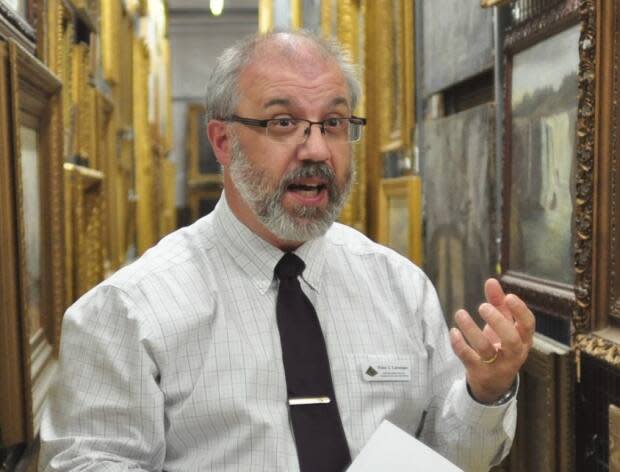Meet the pen that helped fight smallpox — and build first bridge over Reversing Falls

As the worldwide battle against COVID-19 rages on, and at times, progress seems slow and the challenges great, it may be worth a reminder that small things can make a big difference.
Case in point: an unassuming little pen in the collections of the New Brunswick Museum in Saint John.
"It is a lovely, sort of ordinary object," said Peter Larocque, head of the museum's humanities department and curator of cultural history and art, but with "a couple of interesting twists."
This innocuous pen did a lot of work, said Larocque.

The metal pen came into the museum's collections in 1959 from the estate of Eleanor Reynolds Belyea. Her father used it to vaccinate people against smallpox in the late 1800s. And his father used it to plan the first bridge built to completion over Saint John's Reversing Falls.
The combination pen and pencil was made around 1850 by a well-known manufacturing jeweler in England. It could be made of silver, said Larocque, but it's not hallmarked.
It's about 16 centimetres long, or a little over six inches. Its body is fluted and it has a Corinthian-capital-style top.
"It looks like the column that you would see outside of a building like the museum, for example," Larocque observed.

The pen twists apart. It can be used with a pencil attachment or a fountain pen nib.
That's the way Dr. Harlan Reynolds used it on his patients in Lepreau in the 1880s.
But before that, it belonged to William Kilby Reynolds, known as the "projector and builder" of the Reversing Falls suspension bridge, which opened in 1853. Projector means he spearheaded the project.
According to the Historical Marker Database, it all began on a stormy Saturday night, when Reynolds had to row home across the harbour because the ferry wasn't operating. He had a lumber mill in Lepreau, but his family lived in the city.
The historical marker also tells how three previous harbour bridge attempts had failed. Reynolds brought in an engineer from New York who'd just worked on a bridge over Niagara gorge. Construction costs for the Saint John bridge were $80,000. And the suspension bridge lasted for over 60 years, being removed in 1915.

Long before the bridge was torn down, William Reynolds had passed on the now-famous pen to his son.
Harlan Reynolds graduated from the New York School of Medicine 1869, said Larocque, and set up a practice in Lepreau.
A short time later, there was a major smallpox epidemic.
In Montreal, then a city of 150,000, between 3,100 and 6,000 people died, saidLarocque, and 13,000 were infected.
There were also cases in P.E.I.
Mandatory vaccination was ordered in November 1885.
"Everyone was required to be vaccinated without delay," said Larocque.
Because most people arrived by ship or railway in those days, points of entry were deemed the most likely places smallpox would spread. Compulsory vaccination was ordered in Saint John, St. Stephen, Woodstock, Moncton, Shediac and Fredericton "for all persons, male or female, of whatever age, who had not had smallpox."
"Anybody who claimed that they had been vaccinated had to provide satisfactory proof," he said.
"And there was a $20 fine for not being vaccinated or not allowing the health inspectors into your home."
That would be equivalent to thousands of dollars today.

Mandatory vaccines had been talked about before, noted Larocque, including in 1871, when the Common School Act was brought in, requiring New Brunswick children to go to school.
The 1885 order generated "some discussion about individual rights in the newspapers," he said, "but there did not seem to be a huge cry." Perhaps this was because smallpox had been widely reviled for thousands of years as "a scourge of humanity."
It certainly wasn't because getting a vaccine in those days was more fun.
Even though syringes had been invented in the 1850s, they weren't yet in common usage, said Larocque.
A "much cruder method," was used, known as variolation, which, by contrast, makes modern-day needles seem very appealing.
Larocque explained that Dr. Reynolds used his pen to scratch open a patient's skin and apply a serum that contained a low-grade of smallpox.
The nib would either be dipped in the serum or a piece of string or thread would be infused with serum and laid across the wound.
It's worth noting that even that relatively primitive method was a vast improvement on earlier ones, which used actual pus from an infected patient or involved chopping up and snorting someone's pox scabs.
"It's not very pleasant to our sensibilities," Larocque said.
A doctor invented the best method of delivering smallpox vaccine in 1965, he continued.
He used a sewing machine needle, broke the end where the eye is and ground it into a two-pointed fork. The vaccine would be placed in the little space between the prongs, in remarkably similar fashion to the improvised device used by Reynolds 80 years earlier.
"The nib on an old-fashioned pen is quite useful that way," said Larocque.
"It comes down to a point and splits in two."
By January 1886, the measures ordered to deal with the epidemic began to be rescinded, he said.
But smallpox vaccination continued for almost another century.
In 1980, the World Health Assembly declared the disease had been eradicated around the globe.

